您好,登錄后才能下訂單哦!
您好,登錄后才能下訂單哦!
這篇文章主要講解了“結合React源碼如何快速掌握優先隊列”,文中的講解內容簡單清晰,易于學習與理解,下面請大家跟著小編的思路慢慢深入,一起來研究和學習“結合React源碼如何快速掌握優先隊列”吧!
優先隊列是數據結構中的基礎概念,與隊列先進先出(FIFO)的出隊順序不同的是 ,它的出隊順序與元素的優先級相關。
例如 React 的時間分片(React Fiber),它將渲染任務分了優先級,出隊的順序與任務的“重要程度”存在關系,那么滿足這種情況的數據結構就是 優先隊列 。
插入:在優先隊列中插入元素,并使隊列“有序”
刪除最大/最小值:刪除并返回最大/最小的元素,并使隊列“有序”
查找最大/最小關鍵字:查找最大/最小的值
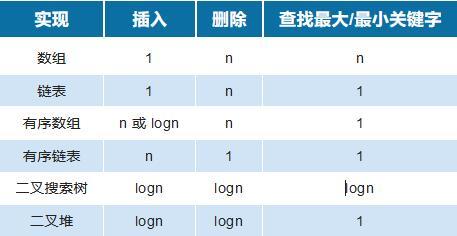
優先隊列可以由以上多種方式實現,而優先隊列的主要操作是插入和刪除,其中二叉搜索樹和二叉堆這兩項操作的時間復雜度均為 logn ,但二叉樹在多次刪除之后容易導致樹的傾斜,同時查找成本也高于二叉堆,所以最終二叉堆是比較符合實現優先隊列的數據結構。
在二叉堆中數組中,要保證每個元素都小于(大于)或等于另外兩個特定位置的元素。例如下圖的樹中,父節點總是小于或等于子節點。
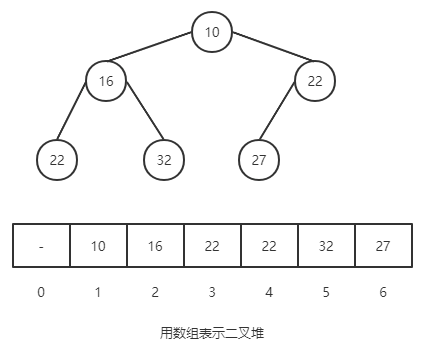
對于二叉堆有如下性質:
節點 k 的父節點下標為 k / 2(向下取整)
已某節點為根節點的子樹,該節點是這顆樹的極值
插入
二叉堆的插入非常簡單,只需要在二叉堆的最后添加要插入的內容,并將其“上浮”到正確位置。
嘗試在上面的二叉堆中插入新元素 9,過程如下:
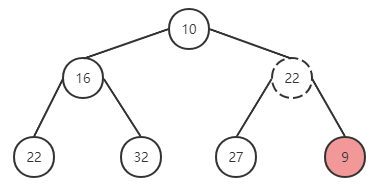
在尾部插入元素 9,與父節點進行對比,有序性被破壞,與父元素替換位置。
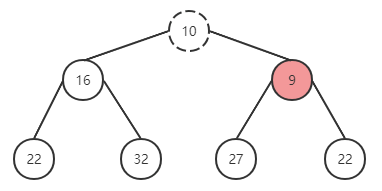
替換成功后,繼續上一輪操作,與父節點進行對比,仍然無法滿足有序性,繼續調換位置。
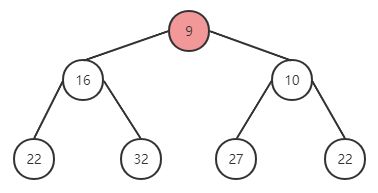
再次替換后符合。
程序框架
function push { * 在堆尾部添加元素 * 執行上浮循環 * 與父元素對比大小,將較大的放在父節點位置 return minItem }實現
function push(heap: Heap, node: Node): void { const index = heap.length; heap.push(node); // 在堆尾部添加元素 siftUp(heap, node, index); // 進行上浮操作 } function siftUp(heap, node, i) { let index = i; while (true) { const parentIndex = (index - 1) >>> 1; // 父節點位置: parentIndex = childIndex / 2 const parent = heap[parentIndex]; if (parent !== undefined && compare(parent, node) > 0) { // The parent is larger. Swap positions. heap[parentIndex] = node; heap[index] = parent; index = parentIndex; } else { // The parent is smaller. Exit. return; } } }刪除
取出根節點的值對比插入稍微復雜一點,歸納起來可以分為三步:
取出根節點的值
將最后一個元素與根節點進行替換,并刪除最后一個元素
下沉
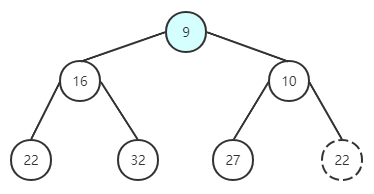
取出根節點。
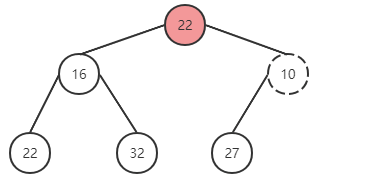
將最后一個元素與根節點調換,并刪除。對比發現有序性被破壞,進行對調。
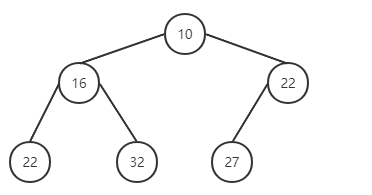
完成刪除。
程序框架
function pop { * 設定 minItem 保存根節點 * 取出最后一個節點與根節點替換,并刪除最后一個節點 * 執行下沉循環 * 將根元素與左右子節點對比,挑選較小的與父節點替換位置 return minItem }實現
export function pop(heap: Heap): Node | null { const first = heap[0]; // 取出根節點 if (first !== undefined) { const last = heap.pop(); // 取出最后一位元素,并刪除 if (last !== first) { heap[0] = last; // 與根節點對調 siftDown(heap, last, 0); // 下沉 } return first; } else { return null; } } function siftDown(heap, node, i) { let index = i; const length = heap.length; while (index < length) { const leftIndex = (index + 1) * 2 - 1; const left = heap[leftIndex]; const rightIndex = leftIndex + 1; const right = heap[rightIndex]; // If the left or right node is smaller, swap with the smaller of those. // 尋找左右兒子較小的那一個替換 if (left !== undefined && compare(left, node) < 0) { //左子節點小于根節點 if (right !== undefined && compare(right, left) < 0) { heap[index] = right; heap[rightIndex] = node; index = rightIndex; } else { heap[index] = left; heap[leftIndex] = node; index = leftIndex; } } else if (right !== undefined && compare(right, node) < 0) { // 左子節點大于根節點,右子節點小于根節點 heap[index] = right; heap[rightIndex] = node; index = rightIndex; } else { // Neither child is smaller. Exit. return; } } }以下是 react 源碼中 scheduler/src/SchedulerMinHeap.js 關于最小堆的完整實現:
/** * Copyright (c) Facebook, Inc. and its affiliates. * * This source code is licensed under the MIT license found in the * LICENSE file in the root directory of this source tree. * * @flow strict */ // 定義最小堆極其元素,其中 sortIndex 為最小堆對比的 key,若 sortIndex 相同,則對比 id type Heap = Array<Node>; type Node = {| id: number, sortIndex: number, |}; // 入隊操作,在入隊完成之后進行“上浮” export function push(heap: Heap, node: Node): void { const index = heap.length; heap.push(node); siftUp(heap, node, index); } // 查找最大值 export function peek(heap: Heap): Node | null { const first = heap[0]; return first === undefined ? null : first; } // 刪除并返回最大值 export function pop(heap: Heap): Node | null { const first = heap[0]; // 取出根節點(哨兵) if (first !== undefined) { const last = heap.pop(); // 取出最后一位元素,并刪除 if (last !== first) { // 頭尾并沒有對撞 heap[0] = last; // 與根節點對調 siftDown(heap, last, 0); // 下沉 } return first; } else { return null; } } // 上浮,調整樹結構 function siftUp(heap, node, i) { let index = i; while (true) { const parentIndex = (index - 1) >>> 1; // 父節點位置: parentIndex = childIndex / 2,此處使用位操作,右移一位 const parent = heap[parentIndex]; if (parent !== undefined && compare(parent, node) > 0) { // 對比父節點和子元素的大小 // The parent is larger. Swap positions. heap[parentIndex] = node; // 若父節點較大,則更換位置 heap[index] = parent; index = parentIndex; } else { // The parent is smaller. Exit. return; } } } // 下沉,調整樹結構 function siftDown(heap, node, i) { let index = i; const length = heap.length; while (index < length) { const leftIndex = (index + 1) * 2 - 1; const left = heap[leftIndex]; const rightIndex = leftIndex + 1; const right = heap[rightIndex]; // If the left or right node is smaller, swap with the smaller of those. // 尋找左右兒子較小的那一個替換 if (left !== undefined && compare(left, node) < 0) { if (right !== undefined && compare(right, left) < 0) { // 左子節點小于根節點 heap[index] = right; heap[rightIndex] = node; index = rightIndex; } else { heap[index] = left; heap[leftIndex] = node; index = leftIndex; } } else if (right !== undefined && compare(right, node) < 0) { // 左子節點大于根節點,右子節點小于根節點 heap[index] = right; heap[rightIndex] = node; index = rightIndex; } else { // Neither child is smaller. Exit. return; } } } function compare(a, b) { // Compare sort index first, then task id. const diff = a.sortIndex - b.sortIndex; return diff !== 0 ? diff : a.id - b.id; }堆排序
利用最大/最小堆的特性,我們很容易就能實現對數組的排序,重復執行 pop 就能進行升序排列,如果要降序,使用最大堆即可,該操作時間復雜度為 nlogn 。
多叉堆
為了追求更優的時間復雜度,我們可以將二叉堆改為多叉堆實現,下圖為一個三叉堆:
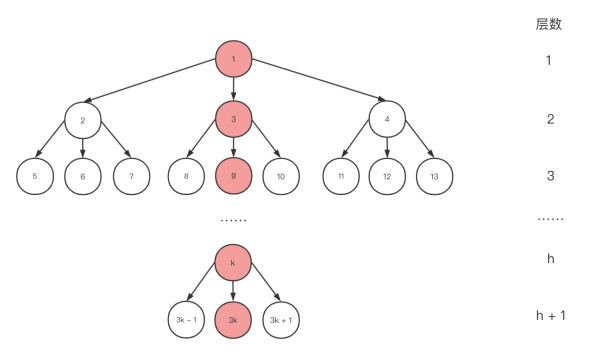
與二叉堆不同的是對于含有 N 個元素的 d 叉堆(通常情況下 d >= 2),隨著 d 的增加,樹高 K = logdN 的斜率會下降,然而 d 越大,刪除操作的成本會更高。所以子元素不是越多越好,通常情況下三叉堆和四叉堆的應用會比較常見。
在libev中有這么一段注釋 https://github.com/enki/libev/blob/master/ev.c#L2227,他提及了四叉樹相比二叉堆來說緩存更加友好。 根據benchmark,在 50000+ 個 watchers 的場景下,四叉樹會有 5% 的性能優勢。
/* * at the moment we allow libev the luxury of two heaps, * a small-code-size 2-heap one and a ~1.5kb larger 4-heap * which is more cache-efficient. * the difference is about 5% with 50000+ watchers. */
同樣 Go 語言中的定時器的 timersBucket 的數據結構也采用了最小四叉堆。
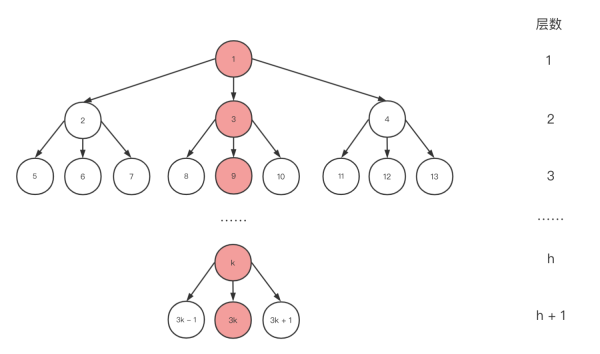
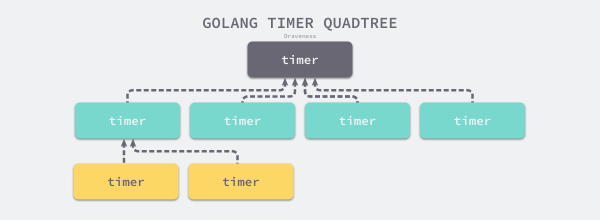
感謝各位的閱讀,以上就是“結合React源碼如何快速掌握優先隊列”的內容了,經過本文的學習后,相信大家對結合React源碼如何快速掌握優先隊列這一問題有了更深刻的體會,具體使用情況還需要大家實踐驗證。這里是億速云,小編將為大家推送更多相關知識點的文章,歡迎關注!
免責聲明:本站發布的內容(圖片、視頻和文字)以原創、轉載和分享為主,文章觀點不代表本網站立場,如果涉及侵權請聯系站長郵箱:is@yisu.com進行舉報,并提供相關證據,一經查實,將立刻刪除涉嫌侵權內容。